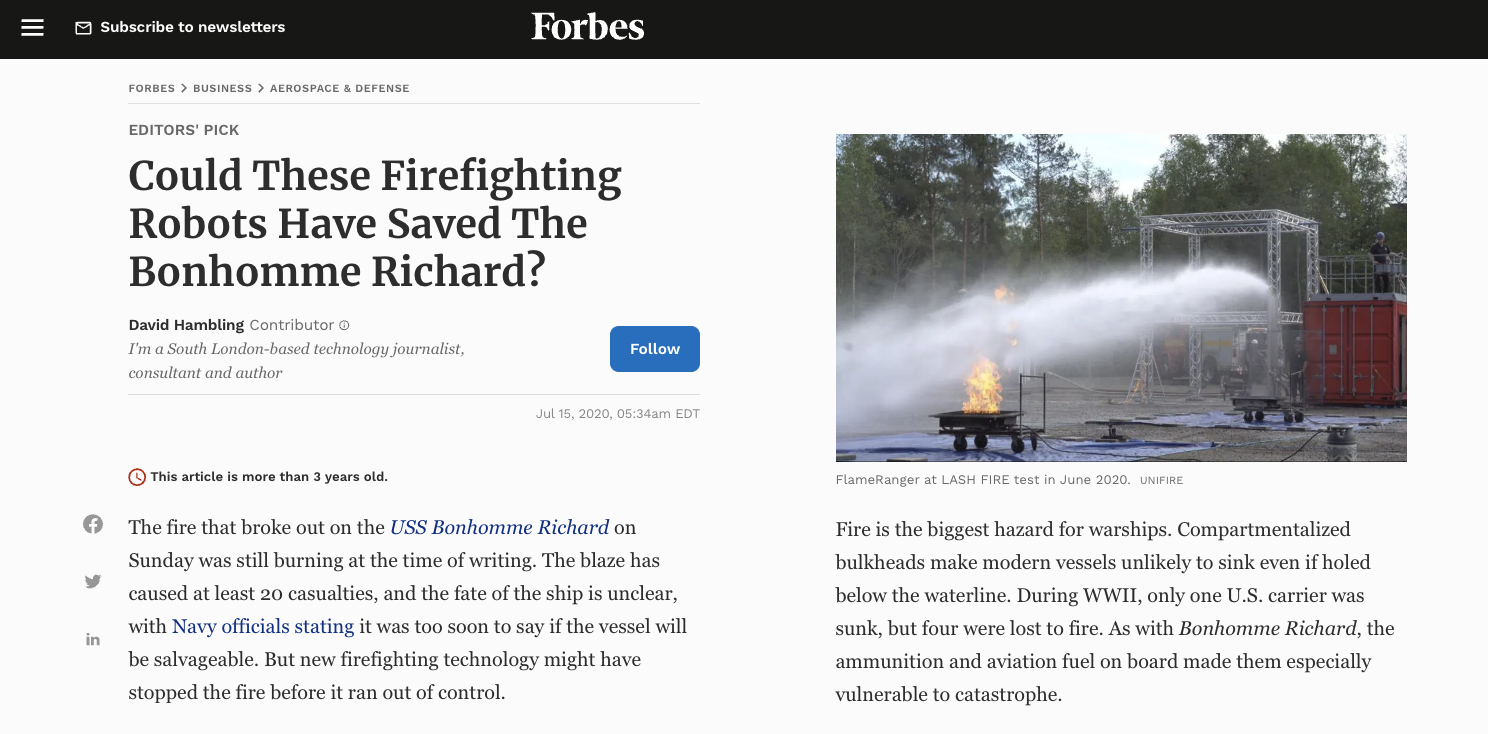
Forbes Magazine on Unifire’s FlameRanger
The following article by Forbes Magazine’s David Hambling (Jul 15, 2020) was originally published at: https://www.forbes.com/sites/davidhambling/2020/07/15/could-these-firefighting-robots-have-saved-the-bonhomme-richard/
Could These Firefighting Robots Have Saved The Bonhomme Richard?
David Hambling
Contributor
I’m a South London-based technology journalist, consultant and author
The fire that broke out on the USS Bonhomme Richard on Sunday was still burning at the time of writing. The blaze has caused at least 20 casualties, and the fate of the ship is unclear, with Navy officials stating it was too soon to say if the vessel will be salvageable. But new firefighting technology might have stopped the fire before it ran out of control.

Fire is the biggest hazard for warships. Compartmentalized bulkheads make modern vessels unlikely to sink even if holed below the waterline. During WWII, only one U.S. carrier was sunk, but four were lost to fire. As with Bonhomme Richard, the ammunition and aviation fuel on board made them especially vulnerable to catastrophe.
Swedish company Unifire say their FlameRanger could make a difference. Claimed to be the most sophisticated robotic firefighting system in the world, FlameRanger comprises sensors linked to nozzles on robotic arms. The sensors, which may include thermal imaging, video analytics and flame detectors, localize a fire in three dimensions and estimate its dimensions. The system then directs a spray at the optimal point to extinguish the fire, shutting it off once the fire has been suppressed. The system can cover large spaces where sprinklers might not be effective, with several of the static nozzle mounts positioned so they can cover the whole area . Other shipboard firefighting approaches are less targeted, involving filling hangar spaces with foam or inert gas which take precious time.
“The technology is now well-proven, extremely cost-effective, and could possibly prevent catastrophic events like the USS Bonhomme Richard fire,” according to Unifire spokesman Roger Barrett James.
FlameRanger can be loaded with water or foam. A human operator can take over the system at any time, remotely controlling the jet with a joystick, tablet, or phone via a WiFi or other internet connection. It is ideally suited to fires like that on Bonhomme Richard that require rapid response.
“Unifire developed the FlameRanger to autonomously and fully automatically detect and combat precisely this type of fire,” says James. “The system responds in seconds and is able to dynamically fight fires much as would a human firefighter operating a remote-controlled water cannon.”
The U.S. Navy has already shown interest in the technology.
“The U.S. Navy successfully tested the system in 2015 for the fire protection of Large Volume Spaces on naval vessels,” says James. “Remarkably, the automatic function was able to extinguish a test fire faster and with less water than a human fighting the same size fire using a joystick to operate the same water cannon.”
The Navy test report notes that the system responded so rapidly that the team starting the test fires had to run out of the test hangar to avoid a soaking. The system was able to extinguish multiple small fires (such as those produced by an explosion, as may have happened on Bonhomme Richard) in seconds.
James says a complete system with flame detectors, control system, software and one robot-steered nozzle start at less than 50,000 Euros. Larger systems cost more but may still be good value.
“For high-value assets with large open spaces, such as naval vessels, the price is nothing compared with the potential savings in the event of a fire,” James adds.
The Bonhomme Richard would cost about $4 billion to replace if it cannot be repaired, according to one estimate.
FlameRanger was recently demonstrated near Borås, Sweden, as part of the EU-funded LASH FIRE project to improve shipboard firefighting. This is aimed at RoRo or Roll-On, Roll-Off ships which carry a mixed selection of trucks and trailers driven and off the vessel. The vehicles may be carrying flammable or hazardous material, so, as with warships, there is a particular need for rapid action.
FlameRanger detected and suppressed four fires in quick succession (video below) in the LASH FIRE demo.
Further ahead, the Office of Naval Research is developing a humanoid robot called SAFFiR to work alongside human firefighters. The Shipboard Autonomous Firefighting Robot looks like a classic mechanical man, designed to move around the same spaces as human. It will be able to operate firefighting equipment and open and close hatches like a sailor, but has the advantages of being able to withstand higher temperatures and sensors (LIDAR and thermal imaging) to see through smoke and spot fires. And crucially, SAFFiRs are expendable, so they can tackle blazes too hazardous for human firefighters.

It may be impossible to prevent fires on Navy ships, but new firefighting technology may keep them under control, saving many lives — and the ships themselves.
.

